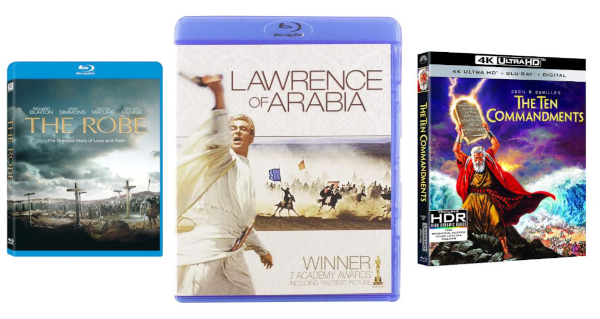Swords, Sand & Sandals: Revisiting CinemaScope Epics

Few of these films are shown on TV today with any regularity, but all are available on disc. The Robe (1953) is best known as the first CinemaScope release (Gentlemen Prefer Blonds was reportedly shot earlier but released later). The Robe is a tale of Christ's crucifixion as seen from the perspective of the Roman tribune who executed it and how it later affected him. It stars Richard Burton as the tribune and Victor Mature as his slave (surprisingly, Mature's performance is the more restrained). A very young Jean Simmons also stars; both Mature and Simmons would later appear in The Egyptian. But perhaps the most surprising performance in The Robe is Jay Robinson's scene-stealing) turn as the manic, infamous Roman emperor Caligula.
For me, The Egyptian, while less overtly religious and definitely pre-Christian (it takes place 1,300 years earlier) is the more effective (and affecting) film. The Robe was followed by an interesting but less significant sequel, Demetrious and the Gladiators.
The Robe is available on Blu-ray with 4-channel audio (L, C, R, mono surrounds). It underwent an extensive restoration prior to its Blu-ray release. Whatever the restorers did, the results were nothing short of spectacular as viewed on a new, 65-inch, QD-OLED TV. The production design is also exceptional, particularly the scenes set in Rome, and Leon Shamroy's cinematography doesn't miss a thing. As much as I was impressed by the images in The Egyptian, The Robe looks significantly better. Shamroy lensed both films, as well as dozens of others. The sound here isn't nearly as impressive, but it's effective enough and makes interesting use of steered dialogue and effects.
Of course we can't ignore The Ten Commandments from Saint Cecil B. Demille. There's plenty of sand and sandals here as well. The cast is a who's who of '50's epic filmmaking. The film is very long, well transferred to video, and available now on a 4K Ultra HD Blu-ray with brilliant color and good (though hardly 2022 state-of-the-art) sound. It was originally shot in VistaVision. Instead of using 35m film, together with the anamorphic process of CinemaScope, VistaVision oriented the width of each film frame vertically, producing a wide image without the need for an anamorphic squeeze. Of course it could only be shown this way in major cities since it required a specially configured and reportedly trouble-prone projector. A transfer to the more conventional 35mm image was needed for wide distribution. Interestingly, VistaVision cameras continued to be used for special effects years after the format was abandoned for feature films (though no longer, as high resolution digital shooting and compositing has largely replaced film).
Jumping forward in both time and film-release-date (2004) we have Hidalgo, the tale of a long, grueling horse race (the "Ocean of Fire") across the Arabian desert. Frank T. Hopkins (a real horse-racer in the late 19th and early 20th century) enters the race with his mustang Hidalgo. Sandstorms, locusts, relentless competitors, and more, make this film a favorite of mine. It's both great fun and emotionally moving, even though the story and race are entirely fictional. As a relatively recent production, both the picture and sound are excellent on Blu-ray, as is James Newton Howard's evocative score.
There's almost as much sand in the tongue-in-cheek The Mummy (1999). Much more lighthearted than any of the above films, it takes what could have been a horrorfest and makes it suitable for almost anyone aged 13 or older. In a quest for a lost, ancient Egyptian city, an irresistible Rachel Weisz plays a smart but slightly ditsy museum researcher who teams up with Brendan Frazer's dissolute escapee from an unidentified foreign legion. They find more than they bargained for. The 4K Ultra HD Blu Ray looks terrific in both light and dark scenes, and the audio is solid. Fraser had other roles, both before and after this one, but with his easy charm and wry humor may have missed his calling as a 20-year-younger, Harrison Ford-like actor capable of handling Indiana Jones-type adventures. He certainly does so here. There were two sequels to this film, but neither is anywhere near as good.
The best, saved here for last of course, has to be director David Lean's Lawrence of Arabia. Peter O'Toole broke into the big time in the title role, surrounded by both known and less familiar stars. Interestingly, a young (here) Omar Sharif also has a smaller but important role in Hidalgo.
Lawrence was an iconic, early 20th century British army officer in WW1 who befriended the Arabs he both fought with and for. Is the story here accurate down to the smallest details? Probably not, but it's at least as close as most historical epics can manage. I have to admit that I've now seen this movie so many times that the shine has worn off a bit, but if you haven't yet seen it, it's a must. It was once my favorite film of all time, though it's now been nudged out of that position by The Lord of the Rings trilogy. The picture holds up well on the conventional Blu-ray. It's also available on 4K HDR, but only at an insane price. But be careful; there's also a Blu-ray version that's clearly labeled "Mastered in 4K." That refers only to the mastering stage; the actual resolution on the released Blu-ray is 1080p.





























































